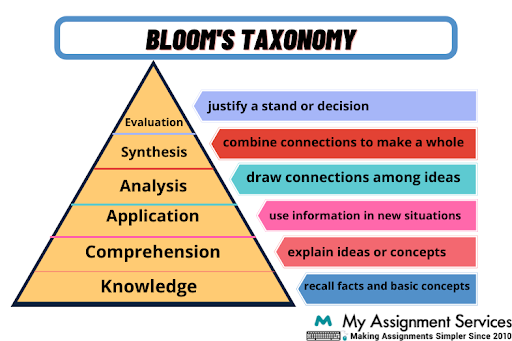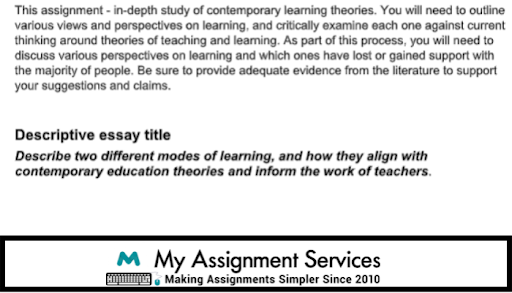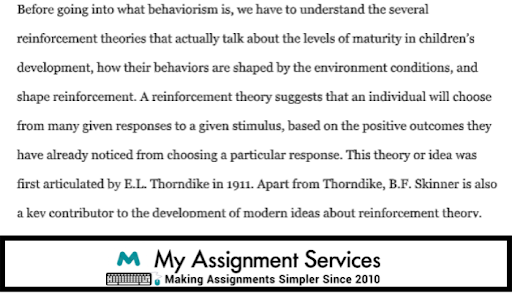Bloom’s taxonomy refers to a hierarchical system of categorizing psychomotor skills or domains and cognitive-affective to help the students learn and teachers for teaching. It provides a common language for the students and teachers to discuss and exchange assessment and learning methods. According to My Assignment Services’ experts, the framework helps educators in developing learning objectives for a particular course. The cognitive domain is linked with intellectual skills and expands knowledge in this framework. The affective domain is coupled with the growth of emotional or feeling aspects of an individual. Psychomotor explain the enhancement of manual or physical skills. Bloom’s Taxonomy Assignments require higher-order thinking skills necessary to accomplish the learning objectives of bigger complexities. We assume you are anxious about your assignment and are looking for Bloom's Taxonomy Assignment Help online. My Assignment Services is here to provide you with online guided sessions where you can instantly clear your doubts and complete your bloom’s taxonomy assignment easily.

Understanding the Concept of Bloom’s Taxonomy
Bloom’s taxonomy derived its name from Benjamin Bloom, the head of the educational committee that devised the taxonomy. It is a three-rank hierarchical structure. It explains the analyzing and thinking skills by following a specific order. This model supports placing the intellectual abilities in varying sections such that few orders of complexity and specificity can be enveloped. For example, the writer does not explain a single sequence for structuring a passage. Scholars use Bloom's taxonomy to understand better and learn a subject, where teachers use it in teaching.
Get Full Understanding of Bloom’s Taxonomy Through Our Expert’s Assignment Help Guided Sessions
Bloom’s taxonomy comprises varying layers of emotions and understanding. To learn about these uneven layers, we resort to applying them. The three levels of Bloom’s taxonomy are mentioned below. But should you need further clarification of any concept, simply contact us to avail our Bloom's Taxonomy Assignment Help. We offer online one-to-one sessions and will clear all your doubts related to your assignments so that you can prepare impressive work.
Cognitive Domain
It incorporates knowledge and the development of intellectual skills. In regard to complexity levels, there are six subsections of the cognitive domain:
- Creation: It includes the manufacturing of new outcomes by the mechanism of designing, creating, planning, and the actual application.
- Evaluation: It includes the mechanism of making judgments and defending points of view regarding the information developed from the application.
- Analysis: It includes evaluating the application, making conclusions, and developing a link between the varying aspects of the application.
- Application: It includes applying the concepts and the knowledge in a more productive and novel manner.
- Comprehension: It includes comprehending the facts compiled during the informational phase productively.
- Knowledge: It includes studying figures, facts, and fundamental topics.
Affective Domain
It considers the emotions and the feelings linked with the passage. It can comprise phenomena, ideas, characters, and conscience (Begam & Tholappan, 2018). The significant part of the affective domain utilized while applying Bloom's taxonomy is characterization, values, reception, organization, and response. There are five stages in the affective domain in ascending order of consequences:
- Stage 1: The learner is a passive observer or listener, focusing on what is taught. This stage is crucial as no learning can take place without it. It manages the learner’s recognition and memory.
- Stage 2: Responding, wherein a learner responds to a stimulus and is active in the learning procedure.
- Stage 3: Valuing wherein a learner links a value to an object, a piece of information, or a phenomenon.
- Stage 4: Organizing where learners can put altogether varying ideas, information, and values, elaborating, comparing, and relating on what they have learned to construct their value structure.
- Stage 5: Characterising where learners use a specific belief or value that now exerts influence upon their behavior such that it becomes a characteristic.
Psychomotor Domain
It includes sensory organ movement, coordination, and the physical mobility of the body as a unit. If you wish to become professional at such skills, much practice is required. Bloom's taxonomy examples regard the action of playing keyboards, driving, guitar, and others as primary examples of this domain.
Online Assignment Help
Custom Essay Help
Dissertation Writing Service
Knowledge Dimensions of Bloom’s Taxonomy
At first, the taxonomy comprised only one dimension: cognitive processes. However, the revised taxonomy launched the knowledge dimensions, which indicate the kind of knowledge to be learned (Irvine, 2017). Our experts who provide Bloom's Taxonomy Assignment Help have advanced knowledge of all the dimensions. Feel free to speak or chat with us and get your queries answered within seconds. These knowledge dimensions are:
- Factual knowledge: They are the significant components. Every scholar must learn about them to be properly acquainted with a specific domain. Also, to resolve any issue it may have. It further incorporates knowledge about particular components, terminology, and information such as significant resources, technical vocabularies, symbols, and others.
- Metacognitive knowledge: This includes basic information about cognition. It also incorporates the understanding and awareness of your comprehension. The knowledge which relates to the metacognitive one involves:
- Cognitive learning like contextual and conditional ones
- Strategic knowledge
- Self-knowledge such as awareness about personal weaknesses and strengths
- Conceptual knowledge indicates the comprehension of the link between the significant components inside a bigger structure. Also, how these links allow the elements to operate as a unit, this set incorporates knowledge of systems, theories, models, categories, principles, generalizations, and classifications such as theorems, historical periods, laws, etc.
- Procedural Knowledge: This includes certain steps and processes to do a few things and finish specific tasks. It also has methods of criteria and inquiry for applying tools, procedures, and skills. This category involves knowledge of when to use particular mechanisms, knowledge of techniques and strategies particularly for the subject, and knowledge of skills and algorithms standard for the theme such as number division, painting, scientific experiments, and practices of interviewing.
Applications of Bloom’s Taxonomy
- Acquiring the meaning of the idioms, words, and phrases is applied in the passage using Bloom's taxonomy topics of application and understanding.
- Acquiring the information mentioned in the passage by applying Bloom’s taxonomy topics of remembering and understanding
- Concluding the factors mentioned in the passage by applying Bloom’s taxonomy topics of analysis and evaluation
- I am considering a good title for the passage by applying Bloom’s taxonomy topics of understanding and evaluation.
- Finding out the writer’s tone by applying Bloom’s taxonomy topics of evaluation
Our bloom's taxonomy assignment help experts will show you how to apply the framework in an inappropriate manner.
What are the Varying Methods of Refining the Speed of Reading?
The main issue in reading a long passage is recalling all the course's significant factors. You are required to read it several times, which will be both energy and time-consuming. According to our Australianassignment help expert’s following practices are significant to manage such a scenario effectively:
- Practice reading
- You need to make sure you can understand what you are reading and hence, do not just continue reading.
- It will help if you read quietly and calmly to be more attentive.
- There is an existing misconception that reading loud enhances the level of understanding. It hinders the speed.
- Allow your eyes to rest while reading and hence, avoid continuous reading.
- Follow a specific space and have a time limit for reading. It would help if you aimed for a lesser time limit when you reach the time mark.
- Consider using a dictionary whenever you encounter a new word. This will help you in pronunciation and understanding.
Bloom's Taxonomy Assignment Sample by Our Experts


The ultimate motive of our experts is to help students understand Bloom’s taxonomy. Our experts will help you know what it is, how it functions, and how to apply the training and evaluation procedure. Bloom's Taxonomy Assignments have evolved immensely over time and provide several positive advantages for educators and learners. Our experts, through online guided sessions, will explain to you Bloom’s six levels of thinking; how to use or apply Bloom's taxonomy whenever creating a course or lesson; to understand the three key domains, which are cognitive, affective, and psychomotor; and how to use Bloom’s taxonomy for both summative as well as formative assessments to aid in active learning. Here is a Bloom's Taxonomy Assignment sample provided by our experts:
Why Choose My Assignment Services for your Bloom's Taxonomy Assignment Help Online?
The framework gives a well-organized structure that every trainer, tutor, and teacher needs to learn efficiently. Here are some of the following features of our Bloom's Taxonomy Assignment Help:
- Lowest price guarantee: Our experts charge a nominal fee of 7% to connect students with quality and highly skilled experts.
- Guaranteed learning outcomes: Enrol into our highly interactive and detailed workshops, conferences, and seminars globally attended by students, professionals, and even the general public.
- Hand help 24*7 support: You are free to contact our experts at any time of the day and avail of our Bloom's Taxonomy Assignment Help to help you score top-notch grades.
- Blazing fast turnaround time: We will respond to all your queries and keep you updated with the progress of your assignment work via the student portal.
24 X 7 Support
100+ Subjects Covered
2000+ Ph.D Experts
References
Begam, A.A A., & Tholappan, A. (2018). The psychomotor domain of Bloom's taxonomy in teacher education.Shanlax International Journal of Education,6(3), 11-14. https://doi.org/10.1109/ISCAIE.2019.8743903
Irvine, J. (2017). A Comparison of Revised Bloom and Marzano's New Taxonomy of Learning.Research in Higher Education Journal,33. Retrieved from: 1128-T46.pdf (ijiet.org)
Get It Done! Today
1,212,718Orders
4.9/5Rating
5,063Experts
Highlights
- 21 Step Quality Check
- 2000+ Ph.D Experts
- Live Expert Sessions
- Dedicated App
- Earn while you Learn with us
- Confidentiality Agreement
- Money Back Guarantee
- Customer Feedback
Just Pay for your Assignment
Turnitin Report
$10.00Proofreading and Editing
$9.00Per PageConsultation with Expert
$35.00Per HourLive Session 1-on-1
$40.00Per 30 min.Quality Check
$25.00Total
Free- Let's Start







